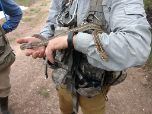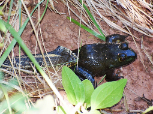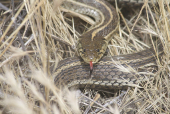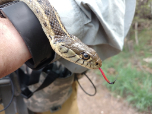Northern Mexican Garter Snake (Thamnophis eques megalops)
Description: Northern Mexican gartersnakes can be difficult to distinguish from other striped gartersnakes. This species has a black, brown, olive, tan, or rust background color with creamy yellow mid-dorsal (center of the back) and side stripes. The critical defining feature is that the side stripes are found on the 3rd and 4th scale rows (counting from the belly scales) near the anterior (front) of the body; in other gartersnakes these stripes are found on the 2nd or 3rd scale rows. This species may have paired dark neck blotches. The head in large adults is often noticeably broad compared to other gartersnakes. Black lines outline the scales on the lower face. Interrupted black lines may also outline the mid-dorsal stripe, and create the appearance of black and white or greenish dashes on the back between the stripes. Younger snakes often have lighter-colored backgrounds; these darken as the snakes age, so that large adults may appear to have a nearly black background color. Adult female northern Mexican gartersnakes can reach 44 inches in total length.
Habitat: Populations occur at lower elevations than narrow-headed gartersnakes (131-6151 feet elevation) in rivers, marshes, lake impoundments, stock tanks, and fish hatcheries.
Range: Northern Mexican gartersnakes are in the Southwestern United States and in the Sierra Madre Occidental and the Mexican Plateau of Mexico; In the United States, the species is found primarily in Arizona, with scattered populations historically present in southwestern New Mexico
Found in these States:
AZ |
NM
Diet: Primary prey items are amphibians and fish; juveniles may also eat earthworms and leeches
Reproduction: Females give birth from 7 to 38 young in June through early July. The birthing season may coincide with the emergence of toad metamorphs or even certain invertebrates. Breeding may occur in spring; more data is needed to determine if breeding also occurs in the fall, as it does in some other snake species.
Status: The northern Mexican gartersnake (Thamnophis eques megalops) is a federally threatened wetland and riparian-obligate snake (USFWS 2014). Critical habitat for this sensitive species has been proposed but not yet finalized (USFWS 2013). This species is protected under Arizona Game and Fish Department Commission Order 43 (Reptiles): no collection, harassment or harming, hunting, trapping, or capture is allowed without special permits.
»» Kingdom: Animalia - Animals
»» Phylum: Chordata - Chordates
»» Subphylum: Vertebrata - Vertebrates
»» Class: Reptilia - Reptiles
»» Order: Squamata - Scaled Reptiles
»» Suborder: Serpentes
»» Superfamily: Colubroidea
»» Family: Colubridae - Colubrids
»» Genus: Thamnophis
»» Species: Thamnophis eques - Mexican Garter Snake
»» Subspecies: T.e. megalops - Northern Mexican Garter Snake
This article uses material from the Wikipedia article "Mexican Garter Snake", which is released under the Creative Commons Attribution-Share-Alike License 3.0. Content may have been omitted from the original, but no content has been changed or extended.
|








